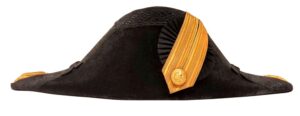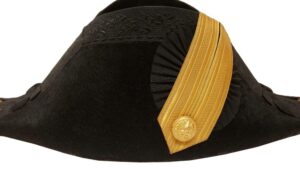U.S.. Naval Officer’s
Bicorn Hat & Epaulets


Presented is a beautiful Naval Bicorn hat and pair of epaulets, in extrodinarily fine condition for their age. The Cocked Hat was worn by officers with full dress uniforms commonly refereed to as a “fore and aft” hat or bicorn. During the 1700’s the hat was worn
parallel to the shoulders, but in the 1800’s was modified to be worn with the points to the front and back. Wearing of
the Cocked Hat was discontinued on 12 October 1940 in the U.S. Navy. This hat is Beaver felt bound with gold bullion accouterments. On each end is a blue and gold tassel. These were worn with full dress uniforms in the 18th, 19th and early 20th century by U.S.Naval officers. Finding an example in like new condition is very rare. As the use of these great uniform pieces cessed around the beginning the of the First WW, these are likely at least 100 years old.

 |
 |
Given the exceptionally like new condition of the interior of the hat, with the trade mark – Trade Mark “Conqueror” – Flex-Air , we think this hat was made very closed to the end of the period that they were used, and was little worn if at all. It is marked at a size 7 1/4.
 |
 |
bar the shoulder is that of a lieutenant and a silver bullion anchor is behind precedes a button embossed with the American
eagle over crossed flags. The underside is marked with right or left and is stamped with a very small Flying Horse stamp at the shoulder end, and “Made in France”.

Underside of Epaulet
The metal carrying case shows the wear of the years, but not the hat and eqauletts.

The bicorne or bicorn (two-cornered) is a historical form of hat widely adopted in the 1790s as an item of uniform by Europe and Amerian Armyy and Naval officers. Most generals and staff officers of the Napoleonic period wore bicornes, which survived as widely-worn full-dress headdress until the 20th century.
The bicorne was widely worn until World War I as part of the full dress of officers of most of the world’s navies. It survived to a more limited extent between the wars for wear by senior officers in the British, French, US, Japanese and other navies until World War II, but has now almost disappeared in that context.
